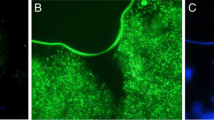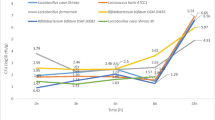Abstract
The objective of this study is to develop a probiotic tablet formulation based on alginate, pectin, and cellulose nanocrystals (CNC) that can preserve high viability of a probiotic bacterium, Lactobacillus rhamnosus ATCC 9595, in gastrointestinal media as well as during storage. A central composite design including three independent biopolymeric material factors (alginate, pectin, and CNC) was applied, and 18 tablet formulations containing probiotic cells were formed. The optimized probiotic tablet based on alginate, pectin, and CNC showed 84 % cell viability after sequential transition through gastrointestinal media, whereas probiotic tablets prepared with alginate, pectin, and CNC individually showed only 19, 17, and 10 % probiotic viability, respectively. Swelling study also revealed that the optimized tablet underwent less dissolution in gastric solution (pH 1.5) and continuous dissolution in intestinal solution (pH 7). The optimized probiotic tablet was stored at 25 and 4 °C for up to 42 days, revealing a reduction of only 0.4 and 0.2 log colony forming units (CFU)/tablet, respectively, after 42 days.




Similar content being viewed by others
References
Adjallé KD, Vu KD, Tyagi RD, Brar SK, Valéro JR, Surampalli RY (2011) Optimization of spray drying process for Bacillus thuringiensis fermented wastewater and wastewater sludge. Bioprocess Biosyst Eng 34:237–246
Ahrabi SF, Madsen G, Dyrstad K, Sande SA, Graffner C (2000) Development of pectin matrix tablets for colonic delivery of model drug ropivacaine. Eur J Pharm Sci 10:43–52
Alexandrescu L, Syverud K, Gatti A, Chinga-Carrasco G (2013) Cytotoxicity tests of cellulose nanofibril-based structures. Cellulose 20:1765–1775
Anonymous (1995) Simulated gastric fluid and simulated intestinal fluid, TS. In the United States Pharmacopeia 23. The National Formulary 18; The United States Pharmacopeial Convention, Inc.: Rockville, MD
Beck S, Bouchard J, Berry R (2012) Dispersibility in water of dried nanocrystalline cellulose. Biomacromolecules 13:1486–1494
Bezerra MA, Santelli RE, Oliveira EP, Villar LS, Escaleira LA (2008) Response surface methodology (RSM) as a tool for optimization in analytical chemistry. Talanta 76:965–977
Bruno FA, Shah NP (2003) Viability of two freeze-dried strains of Bifidobacterium and of commercial preparations at various temperatures during prolonged storage. J Food Sci 68:2336–2339
Caglar E, Kavaloglu SC, Kuscu OO, Sandalli N, Holgerson PL, Twetman S (2007) Effect of chewing gums containing xylitol or probiotic bacteria on salivary mutans streptococci and lactobacilli. Clin Oral Invest 11:425–429
Calinescu C, Mateescu AM (2008) Carboxymethyl high amylose starch: chitosan self-stabilized matrix for probiotic colon delivery. Eur J Pharm Biopharm 70:582–589
Chan ES, Zhang Z (2002) Encapsulation of probiotic bacteria Lactobacillus acidophilus by direct compression. Trans IChemE 80 (part C), pp 78–82
Chan ES, Zhang Z (2005) Bioencapsulation by compression coating of probiotic bacteria for their protection in an acidic medium. Process Biochem 40:3346–3351
Chavarri M, Maranon I, Ares R, Ibanez CF, Marzo F, Villaran CM (2010) Microencapsulation of a probiotic and prebiotic in alginate-chitosan capsules improves survival in simulated gastro-intestinal conditions. Int J Food Microbiol 142:185–189
Cook TC, Tzortzis G, Charalampopoulos D, Khutoryanskiy VV (2011) Production and evaluation of dry alginate-chitosan microcapsules as an enteric delivery vehicle for probiotic bacteria. Biomacromolecules 12:2834–2840
Cook TC, Tzortzis G, Charalampopoulos D, Khutoryanskiy VV (2012) Microencapsulation of probiotics for gastrointestinal delivery. J Control Release 162:56–67
Dong XM, Revol JF, Gray DG (1998) Effect of microcrystalline preparation conditions on the formation of colloid crystals of cellulose. Cellulose 5:19–32
FAO/WHO Experts’ Report (2001). Health and nutritional properties of probiotics in food including powder milk with live lactic acid bacteria. Cordoba, Argentina. ISSN 0254-4725
Gardiner GE, O’sullivan E, Kelly J, Auty MAE, Fitzgerald GF, Collins JK, Ross RP, Stanton C (2000) Comparative survival rates of human-derived probiotic Lactobacillus paracasei and L. salivarius strains during heat treatment and spray drying. Appl Environ Microbiol 66:2605–2612
Habibi Y, Lucia LA, Rojas OJ (2010) Cellulose nanocrystals: chemistry, self-assembly, and applications. Chem Rev 110:3479–3500
Higl B, Kurtmann L, Carlsen CU, Ratjen J, Först P, Skibsted LH, Kulozik U, Risbo J (2007) Impact of water activity, temperature, and physical state on the storage stability of Lactobacillus paracasei ssp. freeze-dried in a lactose matrix. Biotechnol Prog 23:794–800
Hodsdon AC, Mitchell JR, Davies MC, Melia CD (1995) Structure and behaviour in hydrophilic matrix sustained release dosage forms. 3. The influence of pH on the sustained-release performance and internal gel structure of sodium alginate matrices. J Control Release 33:143–152
Howard JR, Timmins P (1988) Controlled release formulation. US Patent: 4,792,452
Huq T, Khan A, Khan AR, Riedl R, Lacroix M (2013) Encapsulation of probiotic bacteria in biopolymeric system. Crit Rev Food Sci Nutr 53:1–8
Iyer C, Kailasapathy K (2005) Effect of co-encapsulation of probiotics with prebiotics on increasing the viability of encapsulated bacteria under in vitro acidic and bile salt conditions and in yogurt. J Food Sci 70:18–23
Khan A, Huq T, Saha M, Khan RA, Khan MA, Gafur MA (2010) Effect of silane treatment on the mechanical and interfacial properties of calcium alginate fiber reinforced polypropylene composite. J Compos Mater. doi:10.1177/0021998310371536
Khan A, Vu KD, Chauve G, Bouchard J, Riedl B, Lacroix M (2014) Optimization of microfluidization for the homogeneous distribution of cellulose nanocrystals (CNCs) in biopolymeric matrix. Cellulose 21:3457–3468
Klayraung S, Viernstein H, Okonogi S (2009) Development of tablets containing probiotics: effects of formulation and processing parameters on bacterial viability. Int J Pharm 370:54–60
Kolakovic R, Peltonen L, Laaksonen T, Putkisto K, Laukkanen A, Hirvonen J (2011) Spray-dried cellulose nanofibers as novel tablet excipient. AAPS PharmSciTech 12:1366–1373
Kovacs T, Naish V, O’connor B, Blaise C, Gagne F, Hall L, Trudeau V, Martell P (2010) An ecotoxicological characterization of nanocrystalline cellulose (NCC). Nanotoxicology 4:255–270
Lavermicocca P (2006) Highlights on new food research. Dig Liver Dis 38:S295–S299
Le-Tien C, Millette M, Mateescu MA, Lacroix M (2004) Modified alginate and chitosan for lactic acid bacteria immobilization. Biotechnol Appl Biochem 39:347–354
Liew CV, Chan LW, Ching AL, Heng PWS (2006) Evaluation of sodium alginate as drug release modifier in matrix tablets. Int J Pharm 309:25–37
Liu L, Fishman ML, Kost J, Hicks KB (2003) Pectin-based systems for colon-specific drug delivery via oral route. Biomaterials 24:3333–3343
Maggi L, Mastromarino P, Macchia S, Brigidi P, Pirovano F, Matteuzzi D, Conte U (2000) Technological and biological evaluation of tablets containing different strains of lactobacilli for vaginal administration. Eur J Pharm Biopharm 50:389–395
Pelkman CL, Navia JL, Miller AE, Pohle RJ (2007) Novel calcium-gelled, alginate-pectin beverage reduced energy intake in nondieting overweight and obese women: interactions with dietary restraint status. Am J Clin Nutr 86:1595–1602
Picot A, Lacroix C (2004) Encapsulation of bifidobacteria in whey protein-based microcapsules and survival in simulated gastrointestinal conditions and in yoghurt. Int Dairy J 14:505–515
Porubcan SR (2006) Formulations to increase in vivo survival of probiotic bacteria and extend their shelf life. US Patent: US 7122370B2
Poulin JF, Caillard R, Subirade M (2011) β-Lactoglobulin tablets as a suitable vehicle for protection and intestinal delivery of probiotic bacteria. Int J Pharm 405:47–54
Revol JF, Bradford H, Giasson J, Marchessault RH, Gray DG (1992) Helicoidal self-ordering of cellulose microfibrils in aqueous suspension. Int J Biol Macromol 14:170–172
Sahadeva RPK, Leong SF, Chua KH, Tan CH, Chan HY, Tong EV, Wong SYW, Chan HK (2011) Survival of commercial probiotic strains to pH and bile. Int Food Res J 18:1515–1522
Saxelin M, Tynkkynen S, Mattila-Sandholm T, de Vos WM (2005) Probiotic and other functional microbes: from markets to mechanisms. Curr Opin Biotech 16:204–211
Sperger DM, Fu S, Block LH, Munson EJ (2011) Analysis of composition, molecular weight, and water content variations in sodium alginate using solid-state NMR spectroscopy. J Pharm Sci 100:8
Sriamornsak P, Thirawong N, Korkerd K (2007a) Swelling, erosion and release behavior of alginate-based matrix tablets. Eur J Pharm Biopharm 66:435–450
Sriamornsak S, Thirawong N, Weerapol Y, Nunthanid J, Sungthongjeen S (2007b) Swelling and erosion of pectin matrix tablets and their impact on drug release behavior. Eur J Pharm Biopharm 67:211–219
Stadler M, Viernstein H (2003) Optimization of formulation containing viable lactic acid bacteria. Int J Pharm 256:117–122
Thakur BR, Singh RK, Handa AK, Rao MA (1997) Chemistry and uses of pectin: a review. Crit Rev Food Sci Nutr 37:1
Timmins P, Delargy AM, Howard JR (1997) Optimization and characterization of a pH-independent extended-release hydrophilic matrix tablet. Pharm Dev Tech 2:25–31
Toft K, Grasdalen H, Smidsrod O (1986) Synergistic gelation of alginates and pectins. In: Fishman ML, Jen JJ (eds) Chemistry and function of pectins, vol 310. American Chemical Society. ACS Series, Washington, pp 117–133
Vasiljevic T, Shah NP (2008) Probiotics—from Metchnikoff to bioactives. Int Dairy J 18:714–728
Acknowledgments
This research was supported by the Natural Sciences and Engineering Research Council of Canada (NSERC) and by FPInnovations (Pointe-Claire, Québec, Canada) through the RDC program. Tanzina Huq is the recipient of a scholarship from Universitaire Fondation Armand-Frappier.
Author information
Authors and Affiliations
Corresponding author
Rights and permissions
About this article
Cite this article
Huq, T., Vu, K.D., Riedl, B. et al. Development of probiotic tablet using alginate, pectin, and cellulose nanocrystals as excipients. Cellulose 23, 1967–1978 (2016). https://doi.org/10.1007/s10570-016-0905-2
Received:
Accepted:
Published:
Issue Date:
DOI: https://doi.org/10.1007/s10570-016-0905-2




